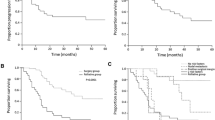Opinion statement
There are limited treatment options for patients with recurrent cervical carcinoma. Because of low response rates and a negligible impact on long-term survival, the use of chemotherapy in patients with unresectable recurrent disease should be considered palliative. Generally, radiation therapy in previously irradiated patients is considered palliative. For patients who develop recurrent disease after definitive surgery who have not received prior radiation therapy, salvage radiation therapy is the treatment of choice. Similarly, patients who have received definitive primary radiation therapy are candidates for surgical resection of their recurrence. However, there are specific criteria for surgical resection. Radical hysterectomy may be an option for the very rare patient with a small (<2 cm) centrally located recurrence in the cervix or vaginal fornices. However, for most patients, pelvic exenteration remains the only therapeutic option that offers the possibility of long-term survival. Patients who are candidates for exenteration are those with central local recurrences that have not extended to the pelvic sidewalls. The introduction of high-dose-rate intraoperative radiation therapy (HDR-IORT) combined with radical surgical resection has widened the scope of patients who may be offered surgery. Patients who in the past may not have been surgical candidates may benefit from radical surgical resection combined with HDRIORT. All patients who are surgically fit and have undergone previous radiation therapy should be considered for surgical resection for centrally located recurrences. Patients whose recurrences extend close to the pelvic sidewalls should be referred to centers where HDR-IORT is available.
Similar content being viewed by others
References and Recommended Reading
Hoskins WJ: Surveying the field of gynecologic oncology. Oncol Spectrums 2001, 2:312–313.
Curtin JP, Hoskins WJ: Pelvic exenteration for gynecologic cancers. Surg Oncol Clin North Am 1994, 3:267–276.
Stehman FB, Perez CA, Kurman RJ, et al.: Uterine cervix. In Principles and Practice of Gynecologic Oncology, edn 3. Edited by Hoskins WJ, Perez CA, Young RC. Philadelphia: Lippincott Williams & Wilkins; 2000:841–918.
National Cancer Institute Clinical Announcement. Concurrent chemoradiation for cervical cancer. February 22, 1999.
National Institutes of Health: NIH Consensus Statement Online. 1996, 43(1):1–38.
Chi DS, Gemignani ML, Curtin JP, et al.: Long-term experience in the surgical management of cancer of the uterine cervix. Semin Surg Oncol 1999, 17:161–167.
Abu-Rustum NR, Hoskins WJ: Radical abdominal hysterectomy. Surg Clin North Am 2001, 81:815–828.
Rubin SC, Hoskins WJ, Lewis JL Jr: Radical hysterectomy for recurrent cervical cancer following radiation therapy. Gynecol Oncol 1987, 27:316–324.
Rutledge S, Carey MS, Prichard H, et al.: Conservative surgery for recurrent or persistent carcinoma of the cervix following irradiation: is exenteration always necessary? Gynecol Oncol 1994, 52:353–359.
Brunschwig A: Complete excision of pelvic viscera for advanced carcinoma. Cancer 1948, 1:177–183.
Abe M, Takahashi M, Yabumoto E, et al.: Clinical experiences with intraoperative radiation therapy of locally advanced cancers. Cancer 1980, 45:40–48.
Gemignani ML, Alektiar KM, Leitao M, et al.: Radical surgical resection and high-dose intraoperative radiation therapy (HDR-IORT) in patients with recurrent gynecologic cancers. Int J Radiat Oncol Biol Phys 2001, 50:687–694.
Del Carmen MG, McIntyre JF, Goodman A: The role of intraoperative radiation therapy (IORT) in the treatment of locally advanced gynecologic malignancies. Oncologist 2000, 5:18–25.
Husain A, Curtin J, Brown C, et al.: Continent urinary diversion and low-rectal anastomosis in patients undergoing exenterative procedures for recurrent gynecologic malignancies. Gynecol Oncol 2000, 78:208–211.
Estape R, Angioli R: Surgical management of advanced and recurrent cervical cancer. Semin Surg Oncol 1999, 16:236–241.
Mirhashemi R, Averette HE, Estape R, et al.: Low colorectal anastomosis after radical pelvic surgery: a risk factor analysis. Am J Obstet Gynecol 2000, 183:1375–1380.
Turns D: Psychosocial issues: pelvic exenterative surgery. J Surg Oncol 2001, 76:224–236.
Levenback C, Morris M: Cervical cancer. In Handbook of Gynecologic Oncology, edn 1. Edited by Barakat RR, Bevers MW, Gershenson DM, Hoskins WJ. London: Martin Duntz Ltd.; 2000:225–241.
Nguyen HN, Nordqvist SRB: Chemotherapy of advanced and recurrent cervical carcinoma. Semin Surg Oncol 1999, 16:247–250.
Author information
Authors and Affiliations
Rights and permissions
About this article
Cite this article
Leitao, M.M., Chi, D.S. Recurrent cervical cancer. Curr. Treat. Options in Oncol. 3, 105–111 (2002). https://doi.org/10.1007/s11864-002-0056-6
Issue Date:
DOI: https://doi.org/10.1007/s11864-002-0056-6




